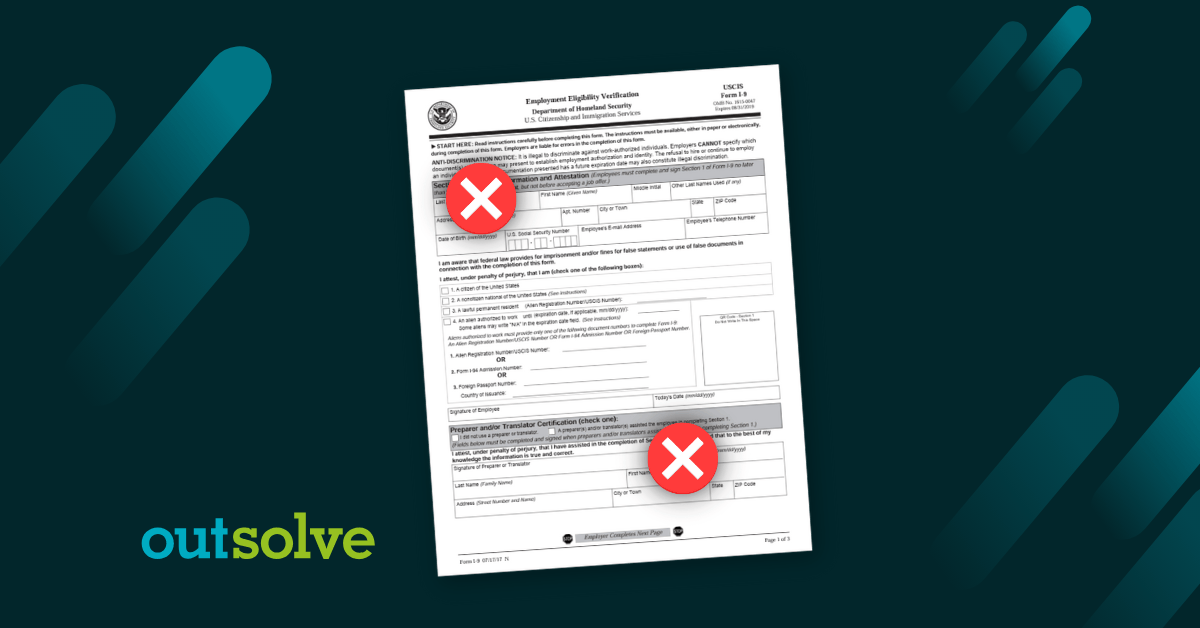
When it comes to employment eligibility verification, few documents are as critical and error prone as the Form I-9. HR juggles compliance, onboarding, and documentation every day, but one misstep with Form I-9 can lead to significant consequences in 2025. This is especially true when it involves what's known as a substantive error.
Here are three key takeaways you’ll learn in this article:
- Define the different types of I-9 errors
- Why understanding I-9 errors is important for compliance
- The top 10 substantive Form I-9 errors and what HR can do to help prevent them
Types of I-9 Errors: Technical vs. Substantive
Errors on Form I-9 typically fall into two main categories. You can have technical, procedural, or substantive errors, which are more serious.
- Technical or Procedural Errors: These are minor mistakes that can sometimes be corrected either before or during an audit. Think of things like forgetting to enter the title of a document or leaving a box unchecked where the correction doesn’t affect the integrity of the form. U.S. Immigration and Customs Enforcement (ICE) typically give employers 10 days to fix these types of errors.
- Substantive Errors: These are the serious ones. A substantive error is a mistake or omission that cannot be corrected after the fact, and it directly affects the validity of the Form I-9. During an audit, these errors typically result in fines, and in some cases, more severe penalties. Substantive errors usually involve missing essential information or noncompliance with core requirements, such as timelines or attestation.
Next, we’ll go through the top 10 substantive Form I-9 errors to watch out for and how to avoid them.
Here are the errors we will cover.
- Failure to Produce Form I-9
- Missing Employee Name in Section 1
- No Box Checked for Citizenship/Immigration Status
- Missing Employee Signature in Section 1
- Missing Employer Signature in Section 2
- Failure to Complete Section 2 Within Three Business Day
- Improper or Missing Document Information in Section 2
- Use of Invalid or Expired Documents
- Failure to Reverify When Required
- Backdating or Falsifying Information
Top 10 Substantive Form I-9 Errors
Here is more detail into each error and tips that HR professionals can begin incorporating to mitigate risk and avoid the costly errors.
1.
Failure to Produce Form I-9 for Employees
This might sound obvious, but one of the most serious violations is simply not being able to produce a Form I-9 at all for an employee. ICE requires that employers retain completed I-9s for all active W-2 employees and there are strict retention requirements for terminated employees. For employees no longer with your company, you must retain the Form I-9 either three years after the hire date or one year after termination, whichever is later.
HR Tip: Conduct periodic audits to make sure that you have a completed Form I-9 for every current employee and that you’ve correctly archived or disposed of older forms.
2.
Missing Employee Name in Section 1
If the employee’s name is not filled out in Section 1, the form is considered incomplete and invalid. This is a textbook example of a substantive error because the form cannot be matched to an individual without it. Also remember that the new hire is required to complete Section 1 on or before their start date. This is a non-negotiable timeline.
HR Tip: Always review Section 1 shortly after it's completed. Look for missing fields, especially the name field, and other identifying info like date of birth and address. Make sure Section 1 is completed within the required timeframe.
3.
Box Checked for Citizenship/ Immigration Status
Section 1 requires the employee to attest to their citizenship or immigration status by checking one, and only one of the four boxes. If this section is blank or if multiple boxes are checked, it’s considered a substantive violation.
HR Tip: While you can't fill this out for the employee, you can and should review it immediately after completion and return the form for correction if you catch the error early.
4.
Missing Employer Signature in Section 2
After verifying the employee’s documents, the employer must sign and date Section 2 to confirm the documents appear genuine and relate to the employee. A missing employer signature invalidates the form.
HR Tip: Don’t delay this step. Complete and sign Section 2 within the required three business days of the employee's start date. That leads us right into the next point.
5.
Failure to Complete Section 2 Within Three Business Days
Employers must review the employee's documentation and complete Section 2 no later than three business days after the employee begins work. Missing this window is a substantive error, regardless of whether the form is eventually completed.
HR Tip: Set calendar reminders or use onboarding software that flags approaching deadlines. Don’t let weekends or holidays confuse you, "business days" matter!
6.
Missing Employer Signature in Section 2
Employers must review the employee's documentation and complete Section 2 no later than three business days after the employee begins work. Missing this window is a substantive error, regardless of whether the form is eventually completed.
HR Tip: Set calendar reminders or use onboarding software that flags approaching deadlines. Don’t let weekends or holidays confuse you, "business days" matter!
7.
Improper or Missing Document Information in Section 2
When completing Section 2, the employer must list the document title, issuing authority, document number, and expiration date, if applicable. Failing to include any of these, especially without retaining a copy, can be considered a substantive error.
HR Tip: Create a checklist or use a template to ensure all required document information is captured accurately during completion.
8.
Use of Invalid or Expired Documents
Employers may only accept unexpired, valid documents from the List of Acceptable Documents. Accepting expired or questionable documents (unless specifically allowed, such as a receipt for a replacement document) is a substantive violation. Also, the employer cannot suggest or influence which documents to present. This is solely the employee’s choice.
HR Tip: Stay current on document changes such as new formats or temporary extensions issued by USCIS. When in doubt, refer to the official Handbook for Employers, also known as M-274.
9.
Failure to Reverify When Required
If an employee presents a document with an expiration date for their work authorization, the employer is required to reverify employment eligibility in Supplement B (formerly Section 3) before the authorization expires. Failing to reverify in time is a substantive error.
HR Tip: Maintain a tickler system that tracks expiration dates of work authorization documents. Start the reverification process at least 90 days in advance. If you use some type of I-9 software or service, these reminders are often built-in.
10.
Backdating or Falsifying Information
This is the most serious error on the list. Backdating a Form I-9, falsifying document information, or forging signatures can result in criminal penalties in addition to hefty fines. These are not only substantive errors, they are violations of federal law.
HR Tip: Cultivate a culture of compliance and integrity. Educate your HR team and hiring managers that shortcuts or “fixes” after the fact are never acceptable and will not be tolerated.
Other Ways HR Can Be Proactive
If you’re feeling a little overwhelmed reading this list, then you’re not alone. The Form I-9 is deceptively short, but the compliance risks are very real. Here are a few proactive steps you can take to protect your organization:
-
Train your HR team regularly. Make I-9 training a part of onboarding for HR staff and refresh that training annually.
-
Perform internal audits. Regular self-audits can help catch errors before an inspection does. Prioritize new hires and reverification cases.
-
Use E-Verify wisely. While it doesn't replace Form I-9, E-Verify can provide an extra layer of protection. Just be sure you're using it correctly and consistently.
-
Stay current. USCIS occasionally updates the Form I-9 or its instructions. Bookmark the USCIS I-9 Central page and subscribe to their updates.
What Substantive Form I-9 Errors Mean for Your Organization
Substantive I-9 errors are not just paperwork mistakes, they are compliance violations that can expose your company to significant legal and financial risk. By understanding what constitutes a substantive error and building processes to prevent them, HR can help their organizations stay on the “straight and narrow” of immigration law and compliance.
The key takeaway here? Don’t treat the Form I-9 as just another onboarding form. It’s a legally mandated document that deserves focused attention and care. Build time into your process to check, double-check, and audit your I-9s. A little diligence today can save a lot of headaches tomorrow.
OutSolve’s Form I-9 employment verification solution offers built-in logic to prevent some of these errors. To learn more about our solution and see how it can help your business improve onboarding and mitigate risk, click below.
Prior to joining OutSolve as a Senior Consultant, Mary worked for several federal contractors preparing non-discrimination reports. She understands the complexity and ever changing demands contractors have to remain compliant. She has over 20 years working in HR and compliance related positions. Mary is a graduate of the University of Louisville, and she brings years of experience in recruiting, non-discrimination reporting and compliance.
Weekly OutLook
Featured Posts

The Federal Government Shutdown Lingers: HR Professionals Take Action

HR Planning: 5 Planning Steps for Q4
Related Posts

Federal Contractor Compliance: What HR Teams Need to Budget For in 2026
2026 is quickly approaching, and HR professionals working in federal contractor organizations have more than just recruiting goals, engagement...

CHRO Survival Guide: Talent, Culture, and Leadership: How CHROs Can Thrive in Uncertain Times
In Part 2 of our CHRO Survival Guide series, we explored the costs of deregulation, the intensity of I-9 and E-Verify enforcement, and the impact of...

The Federal Government Has Reopened: What’s Next for Federal Contractors
As non-essential government offices reopen, human resources, EEO, and compliance professionals in government contractor workplaces may want to...
 Mary Bruce
Mary Bruce

